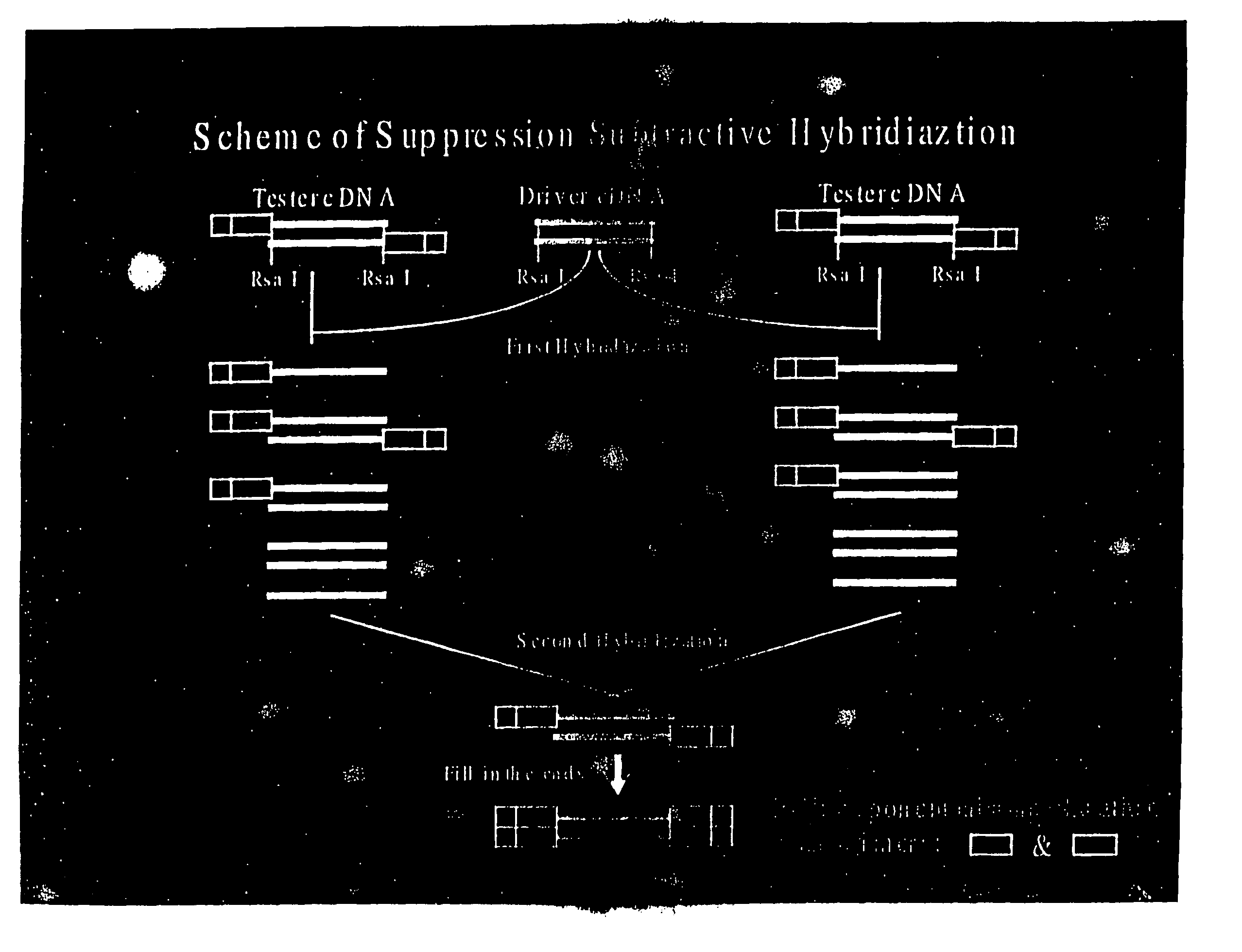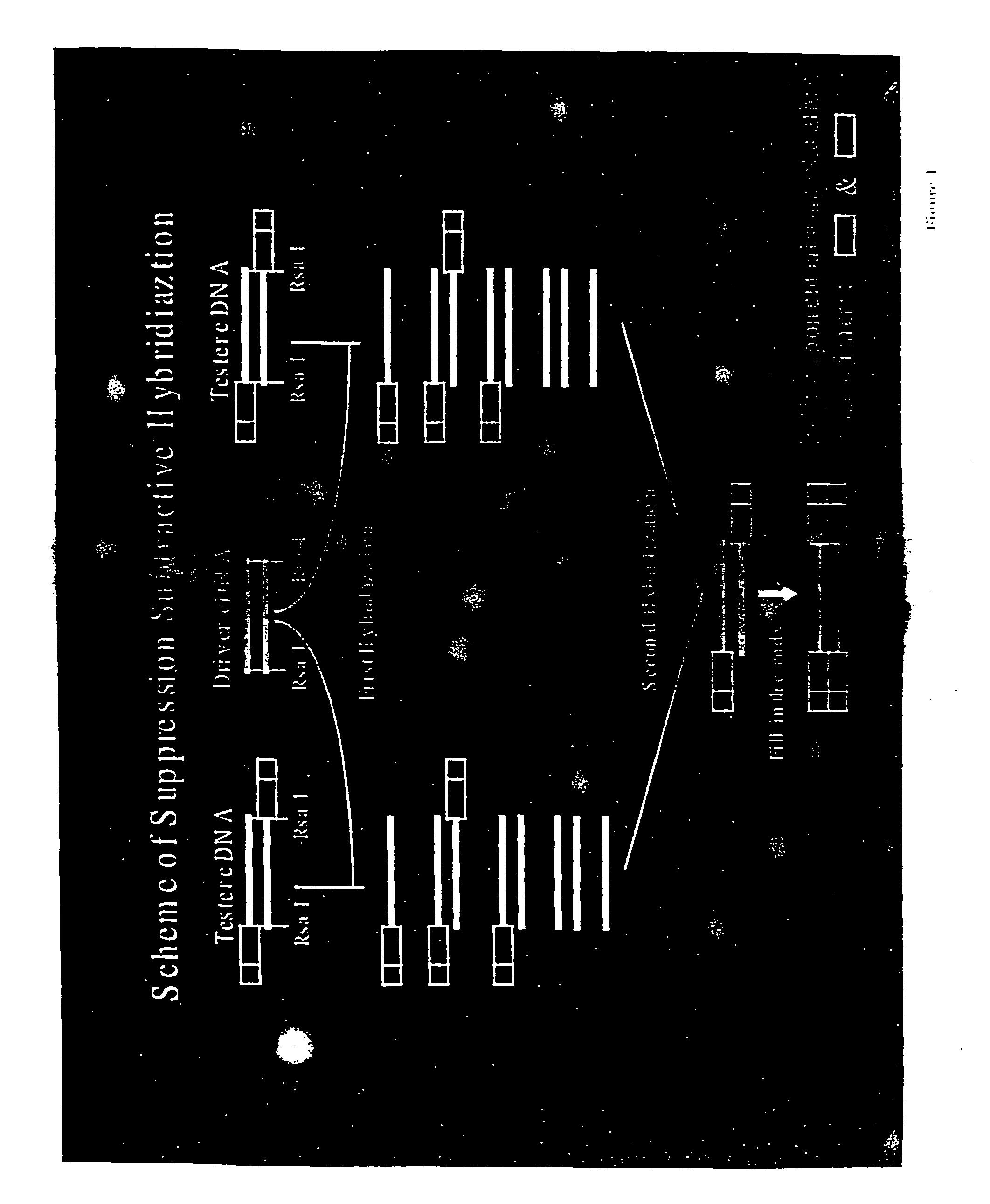Antibodies against inducible TH2 cell factors
a technology of th2 cell factor and antibody, which is applied in the field of modulating the activity of the il9 pathway, can solve the problems of affecting the quality of life of patients, and putting an enormous burden on health care resources
- Summary
- Abstract
- Description
- Claims
- Application Information
AI Technical Summary
Benefits of technology
Problems solved by technology
Method used
Image
Examples
example 1
cDNA Difference Analysis of IL-9 Expressed Genes
[0120] Lungs extracted from transgenic IL-9 mice (TG5) were used to isolate IL-9 induced genes. TG5 is a FVB mouse overexpressing the IL-9 gene as previously described (Renauld et al., (1994) Oncogene 9, 1327-1332). This strain has been shown to overexpress IL-9 in most tissues of the mouse. In order to identify specific IL-9 induced genes, suppressive PCR cDNA difference analysis was performed on mRNA from lungs of TG5 mice and parental FVB mice using a commercially available PCR-select cDNA subtraction kit (Clonetech).
[0121] cDNA synthesis. Total RNA was prepared from lungs of FVB and TG5 mice using Trizol as described by the manufacturer (Gibco-BRL). Lungs were removed from euthanized mice and frozen in liquid nitrogen. Frozen lungs were then placed in Trizol and pulverized using a tissue grinder. Polyadenylated RNA was purified from total RNA with oligo(dT) cellulose columns (Pharmacia). Double stranded cDNA was prepared using Su...
example 2
Identification of the Murine TH2A.F1 cDNA in the Lung of IL9 Transgenic Mice
[0123] Of 836 clones which yielded valid sequence, a novel cDNA has been recovered 17 times. A nucleotide BLAST (Altschul et al., (1990) J. Mol. Biol. 215, 403-410) database search of GenBank with this 321 base fragment revealed that it was most similar to Xenopus cortical granule lectin protein, and it was similar to several mouse EST clones. TH2AF1 primers derived from this 321 base cDNA and from the mouse EST clones were used to do RACE from a lung cDNA RACE kit (Marathon-Ready cDNA, Balb / c male) according to the manufacturer's recommendation (Clonetech). For 5′ RACE, antisense primers mLectin7 (SEQ ID NO: 13), 5′-GGGTTCTTGTAGTCATCACTTGTGGCAG-3′, mLectin9 (SEQ ID NO: 14), 5′-TGCAGACCCAAAGGTGTTGTAGTTGGC-3′ were used; for 3′ RACE, antisense primers mLectin10 (SEQ ID NO: 15), 5′-CTGCCACAAGTGATGACTACAAGAACCC-3′, mLectin8 (SEQ ID NO: 16), 5′-CGTGCAGTGTGGAGACTTTGCTGCA-3′ were used. The PCR fragment were cloned...
example 3
TH2AF1 is Induced In Vivo by IL-9 in Murine Cells
[0125] To confirm that TH2AF1 is induced by IL-9 in the lung, RNA from the lungs of TG5 and FVB mice were isolated as described in Example 1. cDNA was generated using random hexamers (Pharmacia) and Superscript II (Gibco-BRL) as suggested by the manufacturer. Message was analyzed by PCR as described (Nicolaides et al., (1995) Genomics 30, 195-206) and via Northern blot. Primers used to generate murine TH2F1 message were; sense mLectin20 (SEQ ID NO: 17) (nucleotides) and antisense mLectin23 (SEQ ID NO: 18) which produce a gene product of 1,104 base. GAPDH was assayed as an internal control to measure for cDNA integrity using primers previously described (Nicolaides et al., (1991) Genomics 30, 195-206). Amplification conditions used were 94° C. for 30 seconds, 58° C. for 1.5 minutes and 72° C. for 1.5 minutes for 35 cycles. Via Northern blot analysis, total RNA derived from TG5 or FVB lungs was electrophoresed on 1.5% formaldehyde gels...
PUM
| Property | Measurement | Unit |
|---|---|---|
| Fraction | aaaaa | aaaaa |
Abstract
Description
Claims
Application Information
 Login to View More
Login to View More - R&D
- Intellectual Property
- Life Sciences
- Materials
- Tech Scout
- Unparalleled Data Quality
- Higher Quality Content
- 60% Fewer Hallucinations
Browse by: Latest US Patents, China's latest patents, Technical Efficacy Thesaurus, Application Domain, Technology Topic, Popular Technical Reports.
© 2025 PatSnap. All rights reserved.Legal|Privacy policy|Modern Slavery Act Transparency Statement|Sitemap|About US| Contact US: help@patsnap.com



